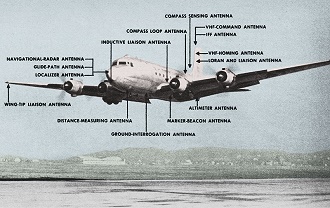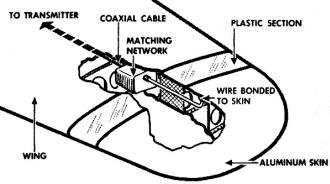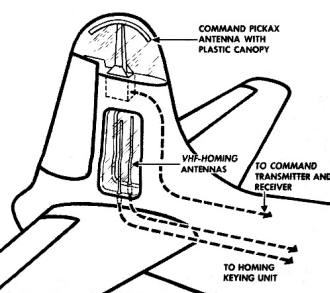Antennas Go into Hiding
|
|||
1949 wasn't all that long of a time since airplane antennas consisted of a hundred feet or more of wire that was spooled out in the air to trail behind the craft, servicing a CW (continuous wave) type radio. The pilot tapped out Morse code on a key strapped to his knee and wrote down the received code as it came in. Prior to landing, the pilot wound the trailing wire antenna back in - which sometimes was forgotten and got ripped off by trees. By the time World War II came around, operating frequencies had moved up in the electromagnetic (EM) spectrum and antennas were accordingly shortened. Still, a review of airplanes at the time showed wire antennas strung from somewhere in the forward region of the airplane (over or under the cockpit) or from the wingtip(s), back to the tip of the vertical fin or tip of the horizontal stabilizer. That was all OK when airspeeds were south of 200 mph or so, but higher speeds caused excessive drag in the air requiring more rugged components, which added to weight. An exposed antenna also was subject to risk of damage from ice, strikes by foreign objects, and oscillation. This Popular Science article reports on some of the many advances made in embedding antennas within the airframe, which was made necessary because of higher airspeeds, reliability, and the accommodation of an ever-increasing number and types of onboard radios. Antennas Go into HidingThere are 16 hidden or flush-mounted antennas in this Air Materiel Command's C-54 flying laboratory, used to test new developments. Buried, the antennas add nothing to aerodynamic drag. Radio and radar devices have been added to airplanes so rapidly that with the accompanying exterior antennas the planes were beginning to look like flying porcupines. And in their other role, as gremlins, the antennas were acting as brakes on the high speeds the Air Force was aiming at. As one radio expert put it. "When they take the propellers off, then we'll take off the antennas." Along came jet propulsion, and, true to his prediction. the experts are burying the antennas to give the speed-of-sound-nudging planes clean-swept exteriors. As an example, figures compiled for only nine of the 16 hidden antennas on the experimental C-54 at the top of this page show that these antennas, if mounted externally, would use up 634 hp. at 600 m.p.h. That's enough horsepower to pull half a dozen automobiles. Among the other advantages of buried antennas are the elimination of icing dangers, added protection against precipitation static, the sealing out of moisture, and freedom from the threat of aerials breaking off at high speeds and interrupting communications.
Posted April 22, 2024 |
|||



